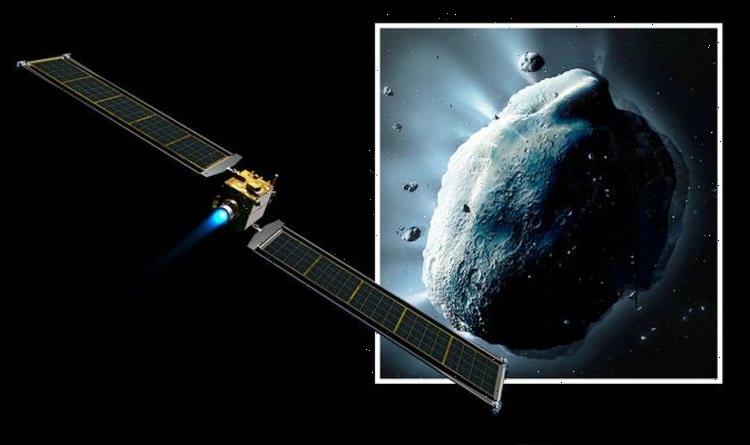NASA testing planetary defence rocket to divert asteroid's path
We use your sign-up to provide content in ways you’ve consented to and to improve our understanding of you. This may include adverts from us and 3rd parties based on our understanding. You can unsubscribe at any time. More info
Officially known as the Double Asteroid Redirection Test, or DART, the mission aims to test NASA’s capacity to steer an asteroid from a potential collision course with Earth. Towards this goal, NASA will slam a golf cart-sized spacecraft into a binary asteroid system scientists have named 65803 Didymos. Although the two space rocks do not pose any threat to Earth, they are the perfect test candidate for DART to prove its mettle.
NASA said: “DART is a planetary defence-driven test of technologies for preventing an impact of Earth by a hazardous asteroid.
“DART will be the first demonstration of the kinetic impactor technique to change the motion of an asteroid in space.”
The spacecraft is presently pencilled in to launch on Wednesday morning at about 6.21am GMT.
Following a brief delay, DART will blast off from the Vandenberg Space Force Base in California, carried aboard a SpaceX Falcon 9 rocket.
However, DART is not expected to rendezvous with Didymos until late September 2022.


At that point in the mission, both the spacecraft and asteroids will be more than 6.8 million miles (11 million km) from the planet.
Speaking at a pre-launch press briefing, NASA’s Lori Glaze, Director of the Science Mission Directorate’s Planetary Science Division, said DART marks humanity’s very first effort to test Earth’s defence capabilities against spaceborne threats.
No asteroid or comet is presently known to pose a threat to the planet but devastating impacts have happened in the past – such as the Chicxulub asteroid that is believed to have wiped out dinosaurs – and it is possible impacts could happen again in the far future.
But the mission also gives scientists an opportunity to learn more about the solar system, how it was born and how it took shape.
Dr Glaze: “The DART mission together with NASA’s other asteroid missions is helping to shape planetary science communities’ better understanding of our solar system and the asteroids and comets there, within the solar system.
Hayabusa-2: Samples from asteroid Ryugu return to Earth
“And not only can we learn more about these small bodies, these comets and asteroids, but they can tell us and inform us more about the origins and evolution of our Sun, Earth, Moon and the other planets and moons in the solar system.
“And in addition, studying these asteroids can shed light on the physical processes that continue to shape our solar system.”
Didymos is comprised of two asteroids, one of which is the smaller Dimorphos or Didymoon.
The “moonlet” measures about 524ft (160m) in size and will be targeted by DART.


According to NASA, this is “more typical of the size of asteroids that could pose the most likely significant threat to Earth”.
The bigger asteroid measures a more impressive 1,560ft (780m) across.
DART will slam into the smaller asteroid at speeds of about 6.6km per second or 14,763mph, which should alter its orbit.
Although the change will only account for about a fraction of one percent, it will be enough to change its orbital period by several minutes – enough to be seen and measured from Earth.
Dr Glaze said: “While these small celestial bodies are awesome, in terms of what we can learn from them, they orbit the Sun just like the Earth, which is why it’s so important that we track and monitor these small objects, as well as develop new techniques that can help us in the future to ensure that one of them and our planet Earth don’t find themselves in the same place at the same time.
“The DART mission is testing one of these methods, a method of asteroid deflection called kinetic impactor technique, where we’re going to ram the spacecraft at high speeds into an asteroid to demonstrate this technique and demonstrate that it’s a viable way to respond if we have an impact hazard in the future.
“The DART mission is a test, so keep that in mind.
“It’s a test and the asteroid we’re going to target, Dimorphos, doesn’t pose a threat to Earth today, nor will it pose a threat to Earth after the impact.”
Source: Read Full Article
